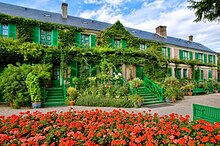Fondation Monet in Giverny

Claude Monet's house from the garden
|
|
| Established | 1980 |
|---|---|
| Location | Giverny, France |
| Coordinates | 49°04′31″N 1°32′02″E / 49.0753559°N 1.5337515°E |
| Visitors | 530,000 (2010) |
| Website | fondation-monet |
The Fondation Claude Monet is a nonprofit organisation that runs and preserves the house and gardens of Claude Monet in Giverny, France. With a total of 530,000 visitors in 2010, it is the second most visited tourist site in Normandy after the Mont-Saint-Michel. The House and Garden have been recognised as a "Maison des Illustres" and "Jardin remarquable" rewarding their outstanding qualities. The estate was classified as a Monument historique in 1976.
Claude Monet lived and painted in Giverny from 1883 to his death in 1926, and directed the renovation of the house, retaining its pink-painted walls. Colours from the painter's own palette were used for the interior -green for the doors and shutters, yellow in the dining room, complete with Japanese Prints from the 18th and 19th centuries, and blue for the kitchen. Monet had the nearby river Epte partially diverted for the gardens and hired up to seven gardeners to tend to it.
When Monet died in 1926, the entire estate was passed on to his son Michel. As he never spent time in Giverny, it was left to Blanche Monet-Hoschedé, the daughter of Alice and the widow of Jean Monet, to look after the garden with the help of former head gardener Louis Lebret. After Blanche died in 1947, the garden was left untended.
Michel Monet died heirless in a car crash in 1966. He had bequeathed the estate to the Académie des beaux-arts. From 1977 onwards, Gérald Van der Kemp, then curator at the Château de Versailles, played a key role in the restoration of the neglected house and gardens, which had been left in a desolate state. In a bid to raise funds, he and his wife Florence appealed to American donors through the "Versailles Foundation-Giverny Inc.". They, thereafter, dedicated themselves to its restoration.
The Fondation Claude Monet was created in 1980 as the estate was declared public. It soon became very successful and now welcomes both French and international visitors from April to November.
...
Wikipedia

